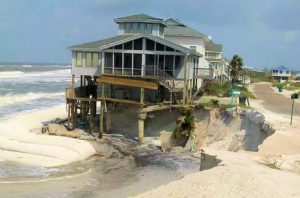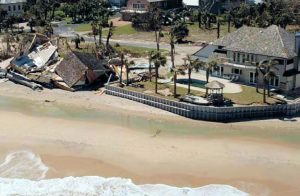
Abstract to the American Shore & Beach Preservation Association
With the start of hurricane season less than a month away, there is a “perfect storm” brewing. This storm, however, is not of the meteorological kind. It’s a storm that pits government and turtle-huggers against beachfront property owners. The regulators have become convinced that all beach nourishment is good, all seawalls are bad. This used to be a debatable issue on a case-by-case basis, but effective efforts by the turtle-huggers has ended all debate. Not that I have anything against sea turtles, but with a little effort and study, it may be possible to protect both the sea turtles and private property rights. Instead, with little to no notice to the affected property owners, the U.S. Fish and Wildlife Service adopted a regulation declaring most of Florida’s sandy shorelines “critical habitat” for the loggerhead sea turtle.
The significance of this action by unelected federal bureaucrats becomes apparent when one considers the fact that coastal construction regulations adopted by unelected Florida bureaucrats prohibits the construction of coastal armoring structures (seawalls, revetments, rip-rap, etc.) “in Federally-designated critical habitat for marine turtles”. While beach nourishment may be the “turtle safe” means to protect upland private property from the effects of critical erosion, beach nourishment typically is a time consuming process, involving both extensive permitting requirements and the acquisition of sufficient funds to accomplish the project.
In many cases, particularly following storm events, beach nourishment is not a practical means to immediately prevent infrastructure and residences from being lost. Even in the absence of a storm event, sea level rise will continue to jeopardize coastal properties. Additionally, as the use offshore sand sources for beach nourishment is discontinued due to environmental and sand quality concerns, the availability and cost of upland sand may make beach nourishment by trucking impractical.
Recently it was reported that the cost of hauling sand by truck is $40 to $60 per cubic yard. On the other hand, the cost of pumping sand from inlets is only $16 to $20 per cubic yard. As the competition for inland sand heats up with the number of coastal communities needing sand for their beach nourishment projects, the cost of hauling sand by truck will skyrocket. If protecting upland private property and public infrastructure by beach nourishment becomes unpractical, and the classification of our beaches as “critical habitat” for the loggerhead sea turtle prohibits protection by armoring, beachfront structures will be left with no protection.
To bring this important matter to the forefront so that appropriate legislative action may be taken before it is too late, I have submitted an abstract of this issue to the American Shore & Beach Preservation Association for presentation at their annual conference in October. a house and road damaged by severe storm related erosion
Please review my abstract at the following link and let me know what you think.
My Abstract
Whether storm induced or the effect of sea level rise, Florida’s shorelines are receding. Three-fourths of Florida’s population reside in counties along more than 1,200 miles of coastline. It has been reported that these coastal counties represent a built-environment and infrastructure whose replacement value was $2.0 trillion in 2010 and is estimated to be $3.0 trillion by 2030. The landward march of the shoreline threatens single and multi-family private residences, as well as the roads and public utilities that serve them. It also threatens the infrastructure that serves public recreational facilities along the coast. Allowing public and private investment in these improvements to become lost to the sea would cripple the State’s economy.
It has long been argued that beach nourishment is the preferred means to address the loss of uplands due to erosion; that coastal armoring will cause or accelerate erosion. However, beach nourishment typically is a time consuming process, involving both extensive permitting requirements and the acquisition of sufficient funds to accomplish the project. In many cases, particularly following storm events, beach nourishment is not a practical means to immediately prevent infrastructure and residences from being lost.

Additionally, finding an appropriate and adequate source of beach compatible sand for beach nourishment purposes is becoming increasingly difficult. Therefore, potentially coastal armoring may be the only viable option. Unbeknownst to most Florida shoreline residents and local government officials, a recent regulation of the U.S. Fish and Wildlife Service has all but eliminated coastal armoring as an option to protect upland structures. On July 10, 2014, an amendment to 50 CFR §17.95 designated significant portions of the shoreline of the State of Florida, as well as neighboring Southeast States, as “critical habitat for the Northwest Atlantic Ocean distinct population segment of the loggerhead sea turtle”.
In Florida, the construction of a seawall, rock revetment, or other rigid coastal structures below the mean high water line of the Atlantic Ocean or Gulf of Mexico, requires a State Coastal Construction Permit pursuant to the provisions of Section 161.041, Florida Statutes and the rules and regulations promulgated there under. Of particular note is Section 62B-41.0055(4), Florida Administrative Code. That rule, most recently amended in 2001, prohibits the construction of coastal armoring structures “in Federally-designated critical habitat for marine turtles”. There is no waiver or variance provision in the rule to avoid the prohibition.
Accordingly, unless circumstances allow for the construction of seawalls, revetments and the like entirely landward of the mean high water line, no State permit may be issued for the construction of rigid shore armoring to protect both private and public structures. Before the next “Big One” hits Florida, it is imperative that public sector and private property owners join forces to remove the prohibition within Section 62B-41.0055(4), Florida Administrative Code. Additionally, the same coalition of interests need to seek an amendment of 50 CFR §17.95 to provide an opportunity to protect existing structures when no other viable option is available.


